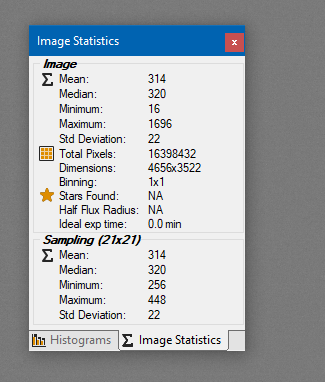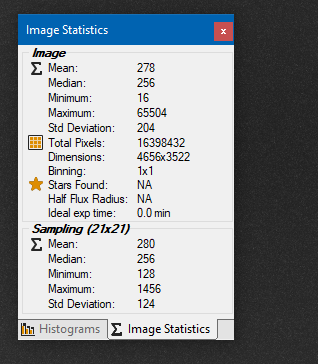I have been imaging with SGP for more than five years using a CCD camera (KAF-8300 chip) but I recently bought a QHY163M camera to get some experience with CMOS technology.
One of the first tasks was to take some bias and dark calibration frames and I immediately noticed something I don’t understand. My 300 second dark frames have a lower, average ADU value than the one second bias frames. I know that CMOS has low dark current, so I would not have been surprised to see dark frames with only a small ADU increase over bias frames – but not to have less!
The QHY163M manual says not to shoot bias frames at 0 exposure time, so I simply selected one second. Here is a screen shot of the “Image Statistics” window with the bias frame showing 314 ADU averages:

And here is the dark frame showing 278 ADU averages:

I repeated this test multiple times with the same results. All frames were shot at 1x1 binning and used the same temperature (-10C) and the same gain and offset values ( g=120, o=20).
So, the question is – Is anyone else seeing similar results with their CMOS calibration frames – with the same camera or other CMOS cameras?
Charlie
Hi Charlie,
this is typical for cameras with the Panasonic MN34230 CMOS sensor. According to a review of this camera model written by Alessio Beltrame, https://www.qhyccd.com/file/fits/Manual/QHY163M_review_EN-1.pdf , (see the chapter “DARK CURRENT”, p. 19) the reason is that the optical black calibration of the sensor overcorrects, due to increasing “amplifier glow”.
Choose an exposure time for bias frames of 0.3 s. This is recommended by QHY as well.
Bernd
@bulrichl
Thanks for the response. I read the referenced document that analyzes the QHY163M camera. One of the best written discussion of CMOS camera performance I have read. It clearly explains why the long exposure dark frames have a lower ADU value than the bias frames (related to amp glow). According to the article, this does need to be taken into account during image processing to avoid getting 0 value pixels.
As a note – I would recommend that anyone using a CMOS camera read the referenced document as its information has applicability to all CMOS cameras.
Charlie
This is indeed important. In my view, the best measure is NOT to pre-calibrate the dark frames. The pre-calibration is absolutely useless, especially if you don’t scale the MasterDark (which should be avoided in any case with this camera because of the “amplifier glow”).
Nevertheless one should check whether the calibrated light frames are clipped in the low range (particularly when short exposure times are applied, or narrowband filters are used), and if clipping occurs, an output pedestal must be applied in the image calibration of the light frames!
Hope this helps.
Bernd

